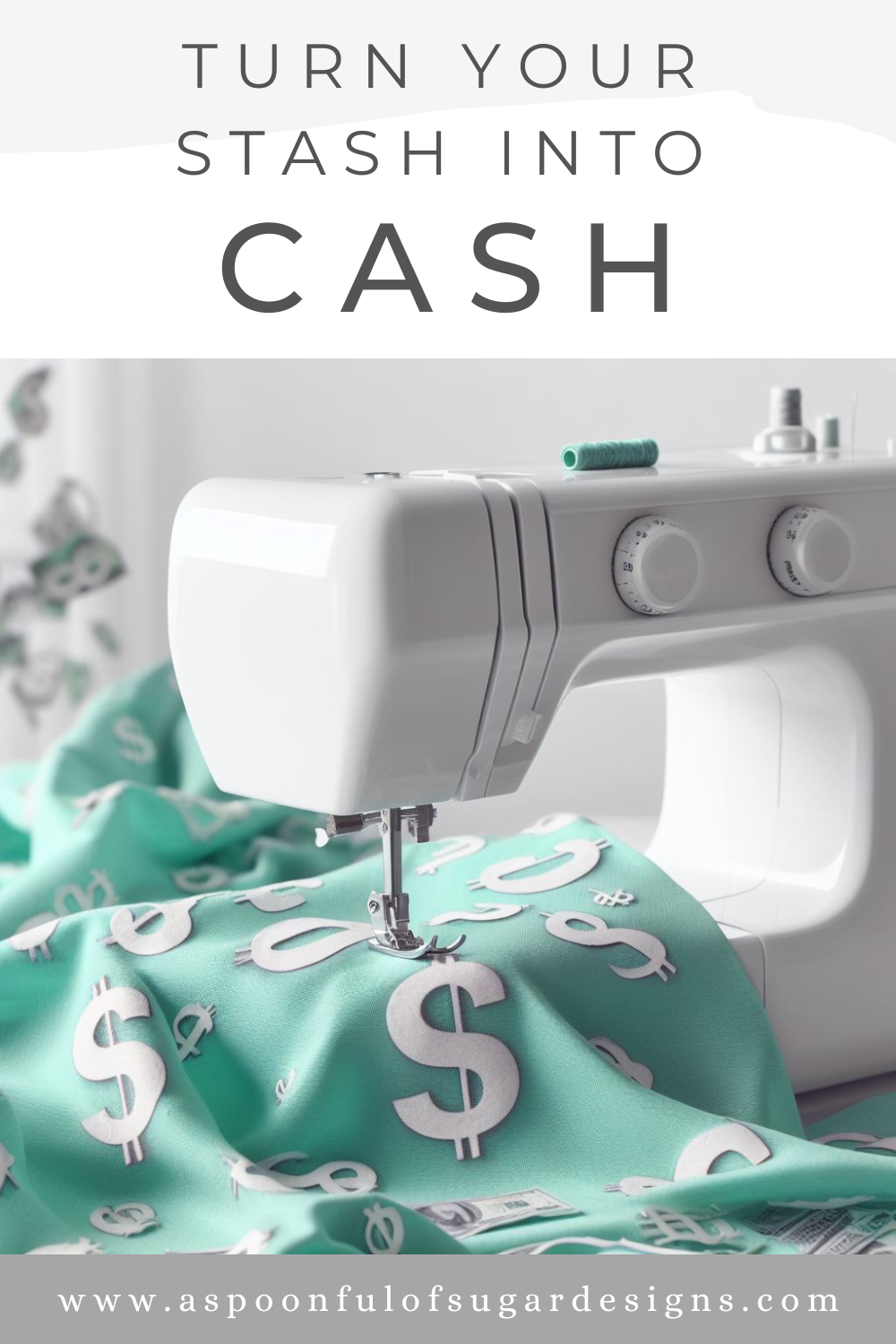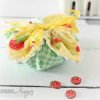
With the cost of living continuing to rise, it is great to have a side hustle to bring in extra money, especially as we head towards the holiday season. Savvy shoppers are appreciating the value of purchasing one of a kind handmade items as unique gifts. If you love sewing and want to make some extra money from your passion, you might be wondering how to turn your hobby into a side hustle. Sewing is a great skill that can be used to create beautiful and useful items that people will love to buy. But how do you go from sewing for fun to sewing for profit?
This is a follow-up article to 10 Projects to Sew and Sell, where I focused on the types of items that are easy to make, popular, and profitable. When you buy any of my patterns, you are able to use the patterns to make items to sell on a small, handmade basis. I would just appreciate that you include it was made using a pattern by A Spoonful of Sugar. Please check your patterns as not all designers allow you to sell items made from their patterns. You can find A Spoonful of Sugar Patterns here: Home – A Spoonful of Sugar Shop (aspoonfulofsugardesigns.com) All our patterns include a license to sell what you sew.

How to turn your hobby into a side hustle
The first step to selling what you sew is to treat it like a business, not just a hobby. That means you need to have a clear vision of what you want to achieve, who your target customers are, and what makes your products unique and valuable. Here are some questions to ask yourself before you start selling:
– What is your niche? What kind of products do you want to sell? Do you want to focus on a specific category, such as bags, quilts, or accessories? Or do you want to offer a variety of items that appeal to different customers?
– Who is your ideal customer? Who are you making your products for? What are their needs, preferences, and pain points? How can you solve their problems or make their lives better with your products?
– What is your unique selling proposition (USP)? What makes your products different from the ones already available in the market? How do you stand out from the crowd? What is your brand story and personality?
– How do you plan to sell your products? Where do you want to sell your products? Do you want to sell online, offline, or both? What platforms or channels do you want to use? How will you handle shipping, packaging, and customer service?
Once you have answered these questions, you will have a clearer idea of how to turn your hobby into a side hustle. You will also be able to set realistic goals and track your progress.

Best projects to sew and sell
The next step is to choose the best projects to sew and sell. There are many factors that can influence this decision, such as:
– Your skills and experience. You want to choose projects that match your level of expertise and confidence. You don’t want to take on projects that are too difficult or time-consuming for you, as they might cause frustration or disappointment. On the other hand, you don’t want to choose projects that are too easy or boring for you, as they might not challenge you or showcase your creativity.
– Your resources and budget. You want to choose projects that fit your available resources and budget. You don’t want to spend more money on materials, tools, or equipment than you can afford or recover from your sales. You also don’t want to waste materials or space by making too many products that don’t sell.
– Your market demand and competition. You want to choose projects that have a high demand and low competition in your niche. You don’t want to make products that nobody wants or needs, or that are already saturated in the market. You also want to avoid making products that are seasonal or trendy, as they might not have a long-lasting appeal or value.
– Your passion and enjoyment. You want to choose projects that you love and enjoy making. You don’t want to make products that feel like a chore or a burden, or that don’t reflect your style or personality. You also want to make products that make you proud and happy, as they will show in the quality and presentation of your work.

Where to Sell your Handmade Items
There are many platforms and venues where you can sell your handmade items, depending on your target market, your budget, and your preferences. Here are some of the most popular options:
Etsy: Etsy is the largest and most well-known marketplace for handmade and vintage goods. You can set up your own shop on Etsy and reach millions of buyers from around the world. However, you will also face a lot of competition and have to pay fees for listing and selling your items. I have had an Etsy Shop since 2012 and have found it a great avenue for reaching new customers.
Shopify and WooCommerce: Shopify and WooCommerce are platforms that allows you to create your own online store and customize it to your liking. You can use Shopify and WooCommerce to sell your handmade items directly to your customers, without any intermediaries. You will have more control over your branding, pricing, and marketing, but you will also have to pay a monthly fee and handle your own shipping and customer service. I have a WooCommerce store attached to my blog.
Craft Fairs and Markets: Craft fairs and markets are events where you can sell your handmade items in person to local customers. You can showcase your products, interact with your buyers, and get immediate feedback. However, you will also have to pay for a booth or table, transport your items, and deal with weather and other factors.
Price Your Products
Next, you need to price your products fairly and realistically. You want to cover your costs of materials, time, and overheads, as well as make a profit. But you also want to be competitive and attractive to your customers.
If you price your items too low, you will lose money and undervalue your work. If you price your items too high, you will lose customers and limit your sales. Here is a simple formula to help you price your items:
- Cost of Supplies + Labor + 10-15% Overhead = Total Costs
- Total Costs x 2 = Wholesale Price
- Wholesale Price x 2 = Retail Price
The cost of supplies is the amount of money you spend on the materials you use to make your item. The labor is the amount of money you pay yourself for the time you spend making your item. You can calculate your hourly wage by dividing your desired annual income by the number of hours you work per year. The overhead is the amount of money you spend on the other expenses of running your business, such as fees, taxes, shipping, packaging, marketing, etc. You can add 10-15% of your total costs to cover your overhead. The wholesale price is the price you charge to retailers or other resellers who buy your items in bulk. The retail price is the price you charge to individual customers who buy your items directly from you.

How to Make Your Items Cost Effective
One of the challenges of selling handmade items is to make them cost effective, meaning that you can cover your expenses and make a profit, while still offering a fair and attractive price to your customers. Here are some ways to make your items cost effective:
Buy Supplies in Bulk: Buying your supplies in bulk can help you save money and reduce your cost per item. You can look for wholesale suppliers, online deals, or clearance sales to get the best prices for your fabrics, threads, zippers, buttons, and other materials.
Use Your Scraps: Using your scraps and leftover materials can help you reduce waste and create new products. You can use your scraps to make small items, such as zipper pouches, coasters, bookmarks, keychains, or fabric flowers. You can also mix and match different fabrics to create unique designs. Check out Sewing with Scraps.
Streamline Your Production: Streamlining your production can help you save time and increase your efficiency. You can streamline your production by planning ahead, organizing your workspace, batching similar tasks, using templates and patterns, and outsourcing or automating some steps.

Marketing
Next, you need to market your products and reach your target audience. You can use various platforms and channels to promote your sewing business, such as social media, blogs, newsletters, podcasts, or videos. You can also join online communities and forums for sewists and crafters, where you can network, share tips, and showcase your work. Another option is to participate in local events and markets, where you can sell your products in person and meet potential customers face-to-face.
The most important tool you can have as a small business owner is an email list so you can reach your customers without relying on other platforms and ever changing algorithms. I have used a few different email marketing providers over the years and Flodesk is hands down the best. I have now been with Flodesk since 2021.
Customer Service
Finally, you need to provide excellent customer service and build a loyal fan base. You want to make sure that your customers are happy with their purchases and that they come back for more. You can do this by offering quality products, fast shipping, secure payment methods, clear policies, and friendly communication. You can also encourage feedback, reviews, referrals, and repeat purchases by offering incentives, discounts, or freebies.
Selling what you sew can be a rewarding and fun way to turn your hobby into a side hustle. It can also help you improve your skills, express your creativity, and connect with other like-minded people.
I hope this blog post has given you some inspiration and guidance on how to get started. Happy sewing!

Need some inspiration on what to sew? Check out our post on 10 Projects to Sew and Sell 10 Projects to Sew and Sell – A Spoonful of Sugar (aspoonfulofsugardesigns.com)
Flodesk Review: Why it is the Best Tool for my Creative Business








This is awesome, thank you. I just wish I could do it. It has always been my dream to work from home.
I hope your make your dream a reality Carol. Good luck!
Thank you for this article. I have tried in tge past to do this but my mistake was trying to sell products in an over saturated market.
Thank you so much for sharing all this great info. I’ve been thinking about selling items, but keep procrastinating and I’m not tech savvy…
Your info is helpful though – and hope to do something in the coming months.
Glad you found some useful info Susan. Good luck in setting up a venture to sell your items.